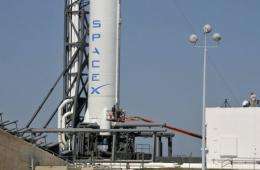SpaceX readies new attempt of rocket launch to space lab (Update)

SpaceX on Monday readied a fresh bid to become the first private company to launch its own craft to the International Space Station after fixing an engine problem that grounded its earlier attempt.
The launch of the Dragon space capsule atop the Falcon 9 rocket is scheduled for 3:44 am Tuesday (0744 GMT) from Cape Canaveral in Florida, on a mission to carry supplies to the orbiting research outpost.
"SpaceX has confirmed that its Falcon 9 rocket is now on track to launch Tuesday," NASA said.
The test flight -- which should include a fly-by and berthing with the station in the coming days -- aims to show private industry is on its way to restoring US access to the ISS after NASA retired its space shuttle fleet last year.
No humans are traveling aboard the Dragon, but six astronauts are already at the $100-billion space lab to help the capsule latch on, to unload supplies and then restock the capsule with cargo to take back to Earth.
The Saturday launch attempt was scrubbed at the last second when computers detected high pressure in the central engine of the Falcon 9.
SpaceX engineers discovered the root cause was a faulty check valve.
"The failed valve was replaced on Saturday and after thorough analysis the vehicle has been cleared for launch," SpaceX spokeswoman Kirstin Brost Grantham said in a statement.
If for some reason Tuesday's launch window cannot be met, another opportunity opens up on Wednesday at 3:22 am (0722 GMT).
California-based SpaceX is the first of several US competitors to try sending its own spacecraft to the ISS with the goal of restoring US access to space for human travelers by 2015.
The company made history with its Dragon launch in December 2010, becoming the first commercial outfit to send a spacecraft into orbit and back. Its reusable Dragon capsule has been built to carry both cargo and up to seven crew.
Until now, only the space agencies of Russia, Japan and Europe have been able to send supply ships to the ISS.
The US space shuttle fleet long served as part astronaut bus, part delivery truck for the lab.
But the three-decade shuttle program ended for good in 2011, leaving Russia as the sole taxi for astronauts to the ISS until private industry comes up with a replacement.
The US space agency has given SpaceX about $390 million so far of the total $680 million that the company has spent on cargo development, according to SpaceX president Gwynne Shotwell.
SpaceX also gets funding from NASA on a separate effort to develop a commercial crew vehicle for carrying astronauts to space, along with competitors Blue Origin, Boeing and Sierra Nevada.
In a few years' time, Shotwell said she hopes SpaceX will be able to undercut the hefty price NASA pays Russia for US astronauts to get a seat aboard the Soyuz space capsule -- around $63 million a ticket.
But in the meantime, SpaceX and NASA have both cautioned that the attempt is risky. Speaking ahead of Saturday's attempt, Shotwell gave the liftoff a 50-50 shot of success.
"Demonstration launches are conducted to determine potential issues so that they might be addressed and -- by their very nature -- carry a significant risk," SpaceX said in a statement on Monday.
"If any aspect of the mission is not successful, SpaceX will learn from the experience and try again."
If the launch goes as planned on Tuesday, Dragon is set to orbit the Earth in May 23 as it travels toward the ISS.
On May 24, the spacecraft's sensors and flight systems are to undergo a series of tests to see if the craft is ready to berth with the space station, including a complicated fly-under at a distance of about 1.5 miles (2.5 kilometers).
If NASA gives the green light, the Dragon will then approach the ISS on May 25 in an attempt to berth with the station.
The astronauts on board the ISS will maneuver the station's robotic arm to help capture the capsule and attach it to the orbiting research outpost.
The hatch of the Dragon is set to open on May 26. On May 31, the Dragon is to detach from the station and make a safe landing in the Pacific Ocean off the coast of southern California.
(c) 2012 AFP





















